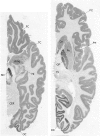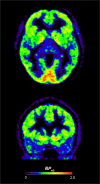The 5-HT1B receptor - a potential target for antidepressant treatment
- PMID: 29546551
- PMCID: PMC5919989
- DOI: 10.1007/s00213-018-4872-1
The 5-HT1B receptor - a potential target for antidepressant treatment
Abstract
Major depressive disorder (MDD) is the leading cause of disability worldwide. The serotonin hypothesis may be the model of MDD pathophysiology with the most support. The majority of antidepressants enhance synaptic serotonin levels quickly, while it usually takes weeks to discern MDD treatment effect. It has been hypothesized that the time lag between serotonin increase and reduction of MDD symptoms is due to downregulation of inhibitory receptors such as the serotonin 1B receptor (5-HT1BR). The research on 5-HT1BR has previously been hampered by a lack of selective ligands for the receptor. The last extensive review of 5-HT1BR in the pathophysiology of depression was published 2009, and based mainly on findings from animal studies. Since then, selective radioligands for in vivo quantification of brain 5-HT1BR binding with positron emission tomography has been developed, providing new knowledge on the role of 5-HT1BR in MDD and its treatment. The main focus of this review is the role of 5-HT1BR in relation to MDD and its treatment, although studies of 5-HT1BR in obsessive-compulsive disorder, alcohol dependence, and cocaine dependence are also reviewed. The evidence outlined range from animal models of disease, effects of 5-HT1B receptor agonists and antagonists, case-control studies of 5-HT1B receptor binding postmortem and in vivo, with positron emission tomography, to clinical studies of 5-HT1B receptor effects of established treatments for MDD. Low 5-HT1BR binding in limbic regions has been found in MDD patients. When 5-HT1BR ligands are administered to animals, 5-HT1BR agonists most consistently display antidepressant-like properties, though it is not yet clear how 5-HT1BR is best approached for optimal MDD treatment.
Keywords: 5-HT1B receptors; Antidepressants; Depression; Serotonin.
Figures


Similar articles
-
Functional Characterization of 5-HT1B Receptor Drugs in Nonhuman Primates Using Simultaneous PET-MR.J Neurosci. 2017 Nov 1;37(44):10671-10678. doi: 10.1523/JNEUROSCI.1971-17.2017. Epub 2017 Oct 2. J Neurosci. 2017. PMID: 28972127 Free PMC article.
-
Clinically effective OCD treatment prevents 5-HT1B receptor-induced repetitive behavior and striatal activation.Psychopharmacology (Berl). 2016 Jan;233(1):57-70. doi: 10.1007/s00213-015-4086-8. Epub 2015 Sep 30. Psychopharmacology (Berl). 2016. PMID: 26423528
-
Essential role for orbitofrontal serotonin 1B receptors in obsessive-compulsive disorder-like behavior and serotonin reuptake inhibitor response in mice.Biol Psychiatry. 2011 Dec 1;70(11):1039-48. doi: 10.1016/j.biopsych.2011.07.032. Epub 2011 Sep 13. Biol Psychiatry. 2011. PMID: 21920503 Free PMC article.
-
Revisiting the Serotonin Hypothesis: Implications for Major Depressive Disorders.Mol Neurobiol. 2016 Jul;53(5):2778-2786. doi: 10.1007/s12035-015-9152-z. Epub 2015 Apr 1. Mol Neurobiol. 2016. PMID: 25823514 Review.
-
Altered γ-aminobutyric acid neurotransmission in major depressive disorder: a critical review of the supporting evidence and the influence of serotonergic antidepressants.Drug Des Devel Ther. 2015 Jan 19;9:603-24. doi: 10.2147/DDDT.S62912. eCollection 2015. Drug Des Devel Ther. 2015. PMID: 25653499 Free PMC article. Review.
Cited by
-
Serotonin 5-HT1B receptors mediate the antidepressant- and anxiolytic-like effects of ventromedial prefrontal cortex deep brain stimulation in a mouse model of social defeat.Psychopharmacology (Berl). 2022 Dec;239(12):3875-3892. doi: 10.1007/s00213-022-06259-6. Epub 2022 Oct 25. Psychopharmacology (Berl). 2022. PMID: 36282287
-
A Meta-Analysis of 5-Hydroxytryptamine Receptor 1B Polymorphisms With Risk of Major Depressive Disorder and Suicidal Behavior.Front Psychiatry. 2021 Jul 12;12:696655. doi: 10.3389/fpsyt.2021.696655. eCollection 2021. Front Psychiatry. 2021. PMID: 34322042 Free PMC article.
-
Associations Between Cognition and Serotonin 1B Receptor Availability in Healthy Volunteers: A [11C]AZ10419369 Positron Emission Tomography Study.Int J Neuropsychopharmacol. 2023 Apr 17;26(4):241-248. doi: 10.1093/ijnp/pyac084. Int J Neuropsychopharmacol. 2023. PMID: 36573320 Free PMC article.
-
Serotonin 1B receptor density mapping of the human brainstem using positron emission tomography and autoradiography.J Cereb Blood Flow Metab. 2022 Apr;42(4):630-641. doi: 10.1177/0271678X211049185. Epub 2021 Oct 13. J Cereb Blood Flow Metab. 2022. PMID: 34644198 Free PMC article.
-
Neuronal atg1 Coordinates Autophagy Induction and Physiological Adaptations to Balance mTORC1 Signalling.Cells. 2023 Aug 8;12(16):2024. doi: 10.3390/cells12162024. Cells. 2023. PMID: 37626835 Free PMC article.
References
-
- Adell A, Celada P, Artigas F. The role of 5-HT1B receptors in the regulation of serotonin cell firing and release in the rat brain. J Neurochem. 2001;79:172–182. - PubMed
-
- Adham N, Romanienko P, Hartig P, Weinshank RL, Branchek T. The rat 5-hydroxytryptamine1B receptor is the species homologue of the human 5-hydroxytryptamine1D beta receptor. Mol Pharmacol. 1992;41:1–7. - PubMed
-
- Anthony JP, Sexton TJ, Neumaier JF. Antidepressant-induced regulation of 5-HT(1b) mRNA in rat dorsal raphe nucleus reverses rapidly after drug discontinuation. J Neurosci Res. 2000;61:82–87. - PubMed
Publication types
MeSH terms
Substances
Grants and funding
LinkOut - more resources
Full Text Sources
Other Literature Sources
Medical

